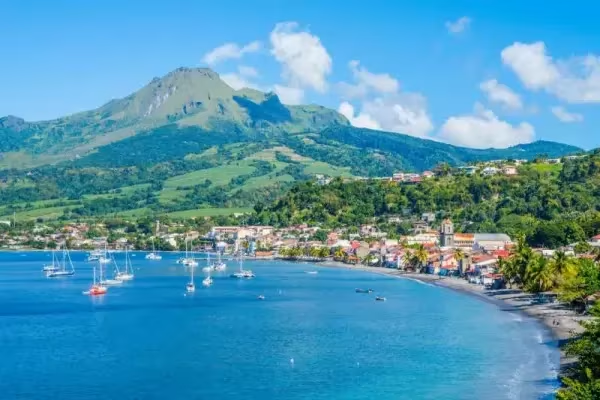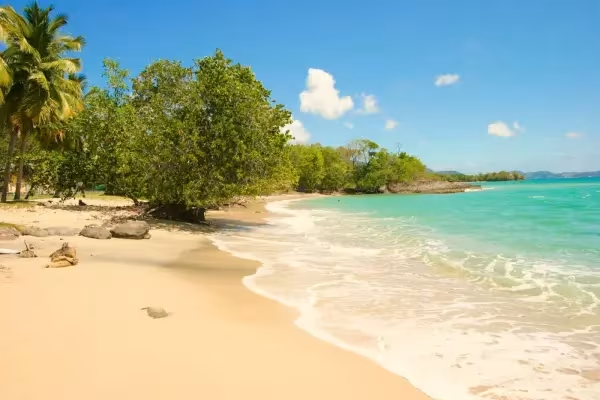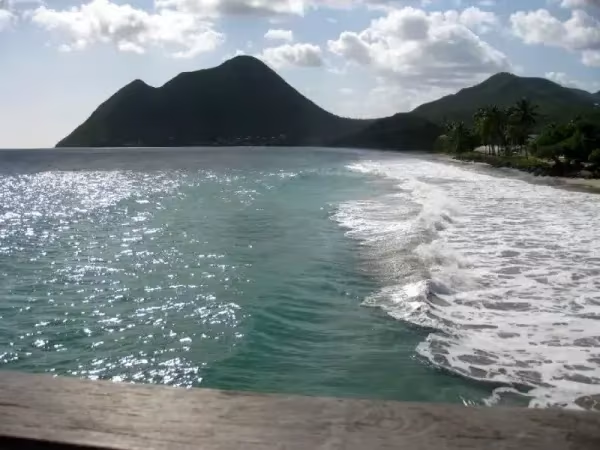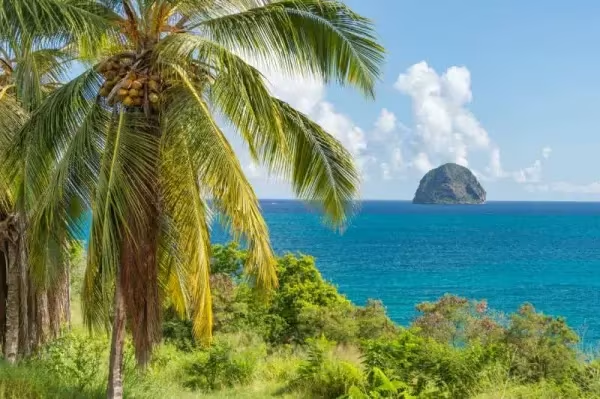💳 Payment 3 x
Easy !
Book now for a trip in 3 months, pay in 3 installments with no fees!
The top landscapes of Martinique
The mountainous landscapes of Martinique
The north of Martinique is essentially composed of mountainous massifs of volcanic origin. Thanks to the climate and the richness of the soils, these massifs are distinguished by the greenery of the forests that cover them. Among them we can mention the famous mount Pelée, morne Macouba or the pitons of Carbet.

Mount Pelee and the bay of Saint-Pierre
The highest point of Martinique with its 1397 m, Mount Pelee is an imposing volcano still active, its last eruption dates from 1932. Well visible from a good part of the island, it offers a superb landscape from the sea or inland.
From the Bay of Saint-Pierre, the panorama is picturesque: the blue of the sea, a narrow strip of sand, a small village and overhanging the whole, the mountain Pelée. If you have time to hike and soak up the nature of the island, Mount Pelee is a must see!
The Pitons of Carbet
Further south, there is a group of volcanic peaks, called the Pitons du Carbet. They also offer a majestic sight from the surrounding lands as well as from the garden of Balata. These different peaks, some of which are really sharp like the piton Lacroix, stand out clearly in the landscape, which makes them even more imposing. All these green peaks are grouped together in a rather small area in which each one competes in altitude (1197 m for the piton Lacroix, 1160 m for Morne Piquet, 1112 m for the piton Dumauzé and 1107 m for the piton of Alma. For the more athletic, there are hikes that allow you to access them and appreciate them more closely.
The landscapes of the seaside in Martinique
Between the sea and the ocean, Martinique logically benefits from beaches, cliffs and bays which are part of the island's fame and which are often found on postcards!
The bay of Fort de France
The bay of Fort de France, also called Bay of the Flemings (in reference to the Dutch refugees who came to the island in the 17th century), is ranked among the most beautiful bays in the world in 2011. The view it gives on the island is splendid, looking further north you can see the wooded foothills of the Pitons du Carbet. Further south, towards Cape Solomon and Trois-Ilets, you can see the beautiful white sandy beaches of Anses d'Arlet. Finally, visible from the bay, Fort de France, the capital of the island stands proudly: you can see the cathedral, Fort Saint-Louis, the port, the complex of Pointe Simon and further on the Mornes.
The Tombolo of Sainte-Marie
There is a tombolo in Sainte-Marie, a strip of sand connecting two stretches of land through the water, often with the presence of a maritime marsh. This Martinique tombolo of nearly 200 m connects Petite Anse and the islet Sainte-Marie. At the end of the year the sand tongue is visible and therefore accessible on foot while in spring it is no longer. In any case, the show offered by the islet from Petite Anse is always striking, with or without visible tombolo!
The beach of Salines
The Salines beach, near Saint-Anne, is probably the most beautiful and famous beach of Martinique. It must be said that it has everything of an idyllic landscape: fine white sand, turquoise waters, coconut trees and in the background, a discreet view on the reclining woman (the mountainous massif).

The reclining woman and the Diamond rock
In Martinique, the reclining woman is a small mountain massif, that of Morne Larcher, located on the communes of Le Diamant and Anses-d'Arlet. It gets its nickname from its particular shape reminding the curves of a woman lying on her back.
Off the woman lying down stands a rock, a volcanic remnant, isolated in the middle of clear waters, a subtlety of the island: the Diamond Rock in the channel of Sainte-Lucie! The sunset on this mountain is dazzling. Don't hesitate to go to the heights of the commune of Le Diamant or to the Sargasso beach.

The Savane des Pétrifications and the point of hell
Almost desert area of the island, the Savane des Pétrifications is a place as surprising as arid. In spite of the geographical proximity, we are far from the green vegetation that we are used to find in Martinique.
The change of scenery is guaranteed with this lunar landscape which was before the plundering covered with petrified trees.
The place, on the seaside, offers high cliffs plunging steeply into the foam, the place is also called the Point of Hell. This scenery is surprising and surprising, discover it during a hike where you can take beautiful pictures.

The peninsula of the Caravelle
Located in La Trinité on the Atlantic coast of Martinique, the peninsula of La Caravelle is yet another spot to discover to enjoy a majestic panorama on the ocean but also on the surrounding nature.
It is home to a nature reserve, a mangrove, colonial ruins, cliffs and beaches! Whether from the sea or from the heights, the landscapes of La Caravelle are among the most beautiful of the island. To your cameras!
The Anses d'Arlet
When you go to the Anses d'Arlet, you are likely to fall in love. Not only for the beach, its Creole charm or its nautical activities but especially for the sublime photographic spotlight that the end of the pier offers on the very colorful Saint-Henri church, enthroned on the seafront. A priceless treasure!
Josephine's Bathtub
Take to the sea in a kayak, water scooter or boat and discover Josephine's Bathtub. Its translucent water and its landscape will leave you speechless. The name "Josephine" comes from the empress Josephine who is said to have liked to bathe there.
To get to and appreciate all the landscapes mentioned and others that we have not mentioned, it is essential to rent a car in Martinique in order to move easily and quickly and thus be able to fully enjoy the time of your stay.

Sign up for our newsletter
And receive our promo codes and exclusive car rental offers in Martinique, delivered straight to your inbox.
Agencies & Pro


Tripadvisor

Qualité Tourisme

Travel award

Kayak
@Europcar Martinique
